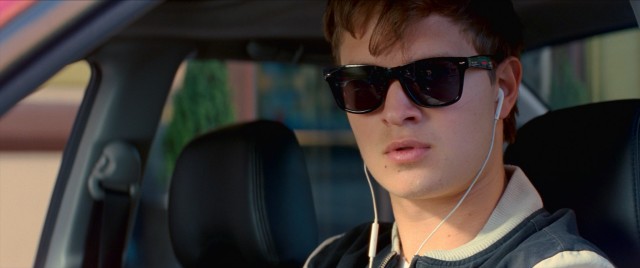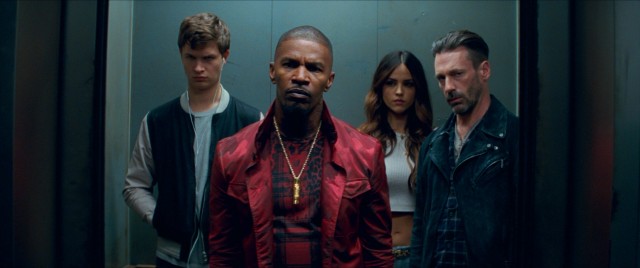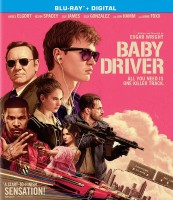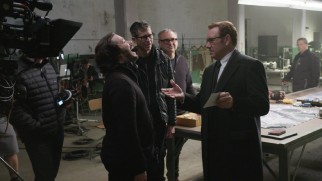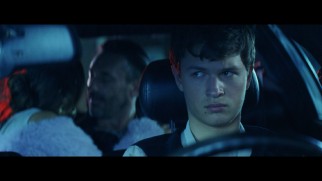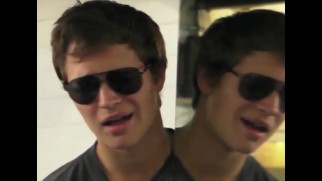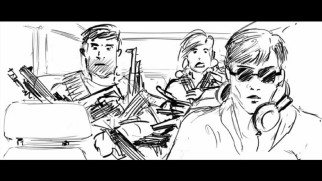Baby Driver Blu-ray + Digital Review
 |
Baby Driver
Theatrical Release: June 28, 2017 / Running Time: 113 Minutes / Rating: R Writer/Director: Edgar Wright Cast: Ansel Elgort (Baby), Kevin Spacey (Doc), Lily James (Debora), Jon Bernthal (Griff), Jon Hamm (Buddy), Jamie Foxx (Bats), Eiza Gonzalez (Darling), Flea (Eddie), Sky Ferreira (Baby's Mom), Lanny Joon (JD), R. Marcus Taylor (Armie), CJ Jones (Joseph) |
Buy Baby Driver from Amazon.com: Blu-ray + Digital HD DVD 4K Ultra HD + Blu-ray + Digital HD Instant Video
Edgar Wright has repeatedly proven himself a versatile and gifted filmmaker. But in his first thirteen years of writing and directing features, he has also established a wheelhouse in accessible, homagey genre British comedies co-written with Simon Pegg and starring Pegg and Nick Frost. The group's Cornetto trilogy of Shaun of the Dead, We open with an impressive dialogue-free scene that establishes Baby (Ansel Elgort, The Fault in Our Stars), a young Atlanta man of few words, as a getaway driver in bank robberies. With earbuds connected to an iPod, Baby calmly waits for more menacing colleagues to do the dirty work and then he navigates the escape with the precision of a veteran stunt driver, evading cop cars, dodging spike strips, switching directions, and confusing helicopters in pursuit. Baby doesn't say a lot, but he doesn't have to either. His driving speaks for itself, though his seemingly tuned-out demeanor sometimes annoys the hardened criminals relying on him.
Baby isn't in bank robberies for the thrill. He owes money to Doc (Kevin Spacey), an influential boss who values the kid's skills and considers him his good luck charm. Baby's debt is nearly cleared and when it is, he takes a job delivering pizzas. It's work his aging deaf foster father (CJ Jones) appreciates, but not something Doc will let him continue, not while there are more heists and weapons deals to pull off. Baby would rather take joyrides with Debora (Cinderella's Lily James), a diner waitress who catches his eye.
Instead of getting to spend time with her, Baby is forced to keep carting such unpredictable wild cards as Buddy (Jon Hamm), his wife Darling (Eiza Gonzαlez), and Bats (Jamie Foxx), who are all highly capable of killing one another or getting everyone killed.
Baby Driver does not build up to one big heist in a formulaic or inevitable way. There's no way to foresee how this will end and even when you think you know, the movie has more surprises in store for you. Final acts are not necessarily Wright's forte. While Hot Fuzz pretty much nails the landing, The World's End falters. Baby Driver's climax runs a bit long and stretches disbelief. Realism is not the principal force of an Edgar Wright film.
What you hope for here and what Wright again delivers is an appealing mix of style and substance. From the opening credits' nimble, uncut stroll placing song lyrics on store windows and the like to the parking garage finale from hell, Wright crafts something unique, As usual, Wright makes music a key component. In this case, Baby has his earbuds in all the time to drown out the tinnitus brought on by a traumatic childhood experience. Wright operates from the anti-Guardians of the Galaxy playbook, picking pop songs of the past that are esoteric yet suitable. I believe I recognized just two of the dozens of prominently featured songs, and audiences will probably join me in recognizing another two only for having had their beats sampled by House of Pain and Dr. Dre. The effect may be similar to Guardians, leading viewers to discover or, less likely, rediscover songs of yore and now associate them with these new contemporary, cinematic thrills.
While Baby Driver extended Wright's record of critical success, it surprisingly also gave him his first taste of true commercial success, grossing over $100 million domestically (which is more than Wright's first four films combined) and another $119 million in foreign markets, its unusually leggy run seemingly due in large part to old-fashioned word of mouth. As the buzz fades and its genre stylings probably keep it out of most awards races, Baby Driver recently hit home video in Blu-ray, DVD, and 4K Ultra HD versions from Sony Pictures Home Entertainment. We review the first of those editions here.
VIDEO and AUDIO The union of an Edgar Wright movie and a Sony Blu-ray yields some awfully high expectations, which Baby Driver fortunately meets with its sharp, vibrant 2.40:1 picture and lively 5.1 DTS-HD master audio sound. Sure, if you're buying into 4K Ultra HD, you'll get more bits there, but by Blu-ray standards, this is perfection.
BONUS FEATURES, MENUS, PACKAGING and DESIGN A sticker on the cover touts "over 2 hours of high octane special features" and it's closer to about seven hours if you're counting audio commentaries. The Blu-ray's extras begin with two of those. The second commentary teams Wright with director of photography Bill Pope, for a more technical discussion of the film. There's enough for the two to fill the air, but it feels less than essential listening with the focus expectedly remaining on the visuals. An Extended & Deleted Scenes section (20:28) consists of eleven sequences. There isn't anything too significant to these, although the dialogue-free version of the ending set to "Easy" does seem better than the one used in the film. A Behind the Scenes section is made up of six featurettes that total 45 minutes and 15 seconds altogether. They range from the general making-of piece "That's My Baby: Edgar Wright" to "Mozart in a Go-Kart" (about Ansel Elgort's stunt driving lessons), "I Need a Killer Track" (a piece on the music), and one about car chases. It's not as easily digested as one documentary, but the content is good.
"Selected Scene Animatics" (35:42) are supplied for eight scenes. They add light animation and the film's music soundtrack to the graphic novel-like storyboard drawings with CGI elements and occasional live-action test and stunt rehearsal footage spliced in. They're probably something you'd be inclined to sample rather than endure in full. The fun Rehearsals & Pre-Production (17:03) serves up Ansel Elgort's second audition (which sees the actor lip-synching by a mirror to the Commodores' "Easy", a song that his knowledge of got the movie prominently inserted into the film), an annotated rehearsal of the "Harlem Shuffle" coffee run, and hair/make-up/costume tests set to excerpts of soundtrack songs.
The Wright-directed 2003 music video for Mint Royale's "Blue Song" (4:15) is included as something that clearly inspired Baby Driver. It features Noel Fielding ("The Mighty Boosh") as a getaway driver picking out the perfect song for his Discman as his colleagues rob a bank. It's a fun inclusion and the kind of thing you'd expect to find more on a Criterion disc than a Sony one. A Complete Storyboard Gallery lets you see the whole film in black and white previsualization drawings, which are more polished than storyboards usually are. The hundreds (thousands?) of drawings are presented in four different galleries.
A Promos & More section holds 21 minutes and 10 seconds of video, starting with three full trailers and proceeding to include a music video for "Chase Me" by Finally, "Previews" repeats the disc-opening trailers for Spider-Man: Homecoming, Rough Night (red band), Life (red band), T2 Trainspotting, The Dark Tower, and Ansel Elgort's November Criminals. It doesn't repeat the tease for Baby Driver bonus features that follows them at the head of the disc. The tastefully scored menu loops clips and moves around the poster art. The disc, which neatly features a car spinning out on a record, is joined by a Digital HD insert in the slipcovered, side-snapped keepcase.
CLOSING THOUGHTS Baby Driver remains one of 2017's most enjoyable films. An appealing blend of style and substance, this action flick shows Edgar Wright is capable of more than just British spoofs and is one of the most talented filmmakers working today. Sony's Blu-ray delights with its feature presentation and piles on enough good extras to make this a no-brainer recommendation. Support this site when you buy Baby Driver now from Amazon.com:
|
Related Reviews:
DVDizzy.com | DVD and Blu-ray Reviews | New and Upcoming DVD & Blu-ray Schedule | Upcoming Cover Art | Search This Site
DVDizzy.com Top Stories:
Written and Directed by Edgar Wright: The World's End Scott Pilgrim vs. the World Hot Fuzz
New to Disc: A Ghost Story Guardians of the Galaxy Vol. 2 The Hero Wonder Woman
Ansel Elgort: Divergent Men, Women & Children | Jamie Foxx: Horrible Bosses The Soloist The Amazing Spider-Man 2
Kevin Spacey: Elvis & Nixon 21 The Usual Suspects | Jon Hamm: Million Dollar Arm Friends with Kids Keeping Up with the Joneses
Drive Logan Lucky Logan
Text copyright 2017 DVDizzy.com. Images copyright 2017 Sony, TriStar Pictures, Media Rights Capital, Working Title, Big Talk Pictures, and Sony Pictures Home Entertainment.
Unauthorized reproduction prohibited.
